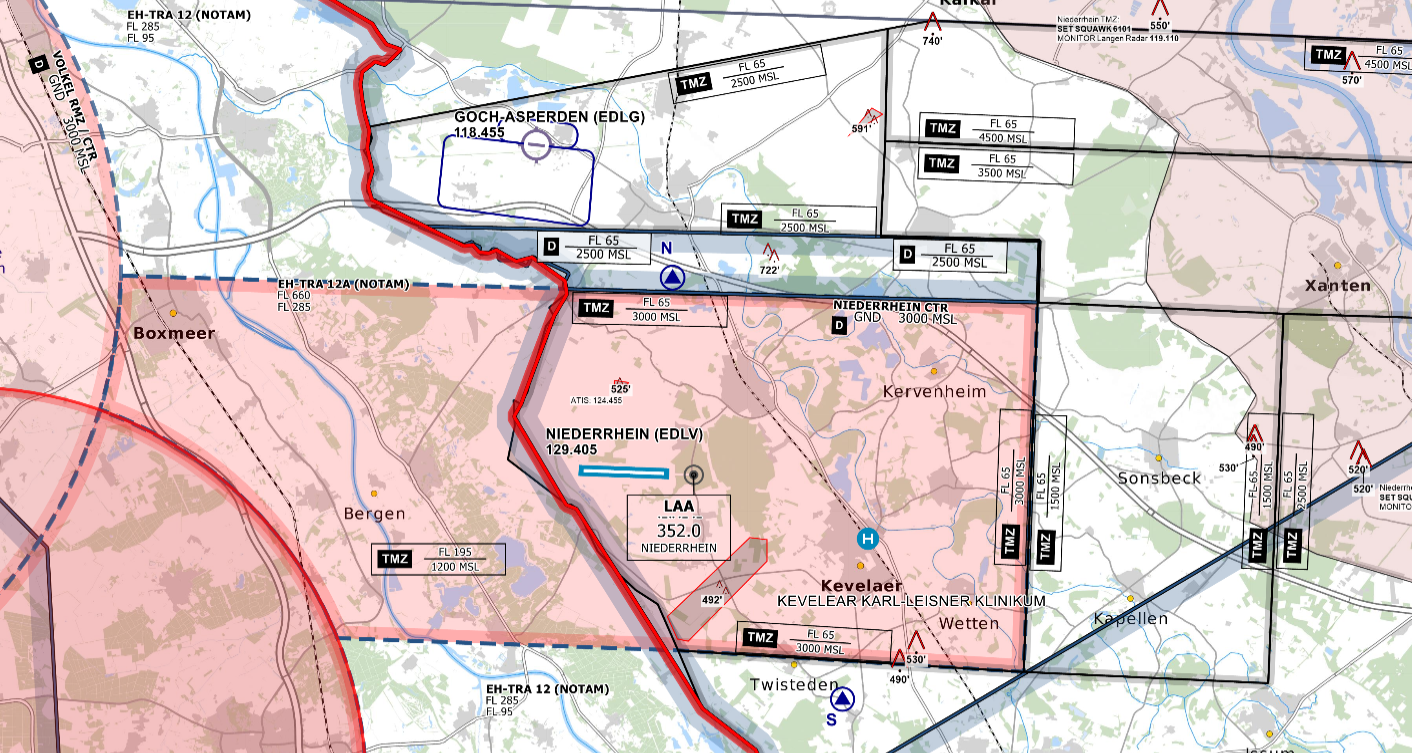Tower
Niederrhein/Weeze Airport is located on German territory, directly on the border with the Netherlands. To the west, the control zones of the Dutch airports De Peel (EHDP) and Volkel (EHVK) border directly on Niederrhein.
The tower is responsible for all traffic at the airport and within the control zone, including startup,startup and enroute clearanceclearances andas well as all ground movements.
DepartureEnroute Routesclearance
Niederrhein
SID restrictions
| Waypoint |
Remark |
| SONEB |
only reclear
|
Control ZoneAirspace
The western half of the airport's control zone is over Dutch territory and extends to 3000 ft AMSL. Entry and exit is possible via the mandatory reporting points November and Sierra on the German side of the CTR. Max Altitude for both VFR routes 2500ft above MSL.
Overview

Niederrhein/WeezeNiederrhein Kontrollzone (D-CTR)CTR - © openflightmaps.org
CTR
TMZ:The OutsideWestern half of the controlairport's zoneCTR is over Dutch territory and directly borders the CTRs of the Dutch military airfields Volkel and De Peel.
VFR traffic can only enter and exit the CTR over German territory, primarily via reporting points N and S. The maximum altitude for entering and exiting the CTR is 2500ft AMSL. Direct transitions between the CTRs of Niederrhein and Volkel or De Peel are possible after coordination with the responsible Dutch controller.
TMZ
The CTR is surrounded by a TMZ wherein allwhich VFR aircraftpilots must setsquawk transponder6101 code 6101. The pilot mustand monitor the frequency of the responsible radar controller.
Helicopters
Helicopter: All helicopters must take off or land on the active runway at the airport. This is followed or preceded by hovering to/from the target position at the airport.
Direction of Operation
Operating direction 27 is preferred up to a tailwind component of 5 KT. In addition, this is the only runway for which an ILS approach is available. In LVO conditions, only the ILS approach to runway 27 (CAT III) is available for all approaches.
Opposite departures
Departure against the operating direction: In close consultation with the responsible radar controller, departures against the current operating direction are also possible in Niederrhein. This procedure is mainly used during 27 operations with a slight tailwind.tailwind.
Taxiway Restrictionsrestrictions
Taxiways B and C may only be used by aircraft up to max. code C (B739/A321) after landing to leave the runway. No intersection departures are permitted in Niederrhein!
Parking Positionspositions
All parking positions in Niederrhein are designed for amax. maximum of Codecode C aircraft (B739/A321). All larger aircraft block both the taxiway behind the position and the neighbouring positions. If, in exceptional cases, an aircraft larger than Codecode C should land, the taxiway between positions 1 to 6 can be used for parking. Until then, only positions 7 to 9 can be used for other traffic! PushbackPushbacks isare required at all parking positions.
GA Terminals 1 and 2 can be used for general aviation aircraft.
Auto-Handoffhandoff
Weeze utilizes an auto-handoff procedure for IFR departures where Tower will not hand off outbounds to the approach/center controller. Make sure to set the correct departureairborne frequency in the ATIS.
Outbounds should contact APP/CTR immediately when airborne unless explicitly told to remain on Tower frequency.
